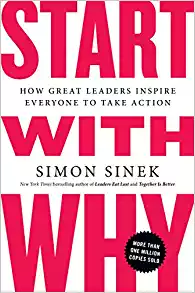The Importance of Asking “Why” from the Moment You Have a Glimmer of an Idea for an Event or Attraction
By Brad Jashinsky & Philip Hernandez
It seems to us that the attractions industry—especially start-up attractions like escape rooms and haunted houses—need to ask this question: “Why am I doing this? Why will my audience be excited about this?” Often they dive into expanding on an idea, go full-on into the marketing, and hope the marketing will make it all work out.
Listen to the episode here.
Recommended Reading:
“Start with Why: How Great Leaders Inspire Everyone to Take Action”
by Simon Sinek.
How to Know When Marketing is a Waste of Time
Forbes magazine had an article on February 28th of this year (2018) about how to know when marketing is a waste of time; the biggest takeaway from the article had to do with businesses that focus on marketing before they figure out what they’re marketing and why anyone should care. Many upstart attractions seem to think it’s okay to be just another escape room or another haunted house. You have to be unique to draw guests. You have to think about what your average customer/guest will think of your attraction. What will differentiate you? Marketing before you have a defined ‘why’ behind what you’re doing will only waste money.
The Real Competition
We’re not necessarily just competing with other attractions. We’re primarily competing with entertainment as a whole. We’re particularly competing with entertainment on the Internet in which people don’t even need to leave their house. Aero Electronics, which owns 53 media properties in the electrical engineering space (IE the entire media) frames it well: “We’re not just competing on a product level. We’re competing on an industry level.” That’s what you have to keep in mind when asking yourself “why?”
Bring Marketing in from the Beginning, and Ask Why at Every Stage
Whether your attraction is already designed or you’re just thinking of doing a haunted house or an escape room, it’s never too late to ask why. Of course, it’s always better to ask why before you begin designing your attraction, but it is never too late.
The Internet has revolutionized marketing and products. Marketing used to be pretty siloed. There was the product mix, and marketing was just part of the process to get that product out there. Marketing is now much more involved in the strategy of the whole process. Marketing is brought in early—often before there’s even a product—to look at the overall strategy holistically. It’s no longer, “Here’s the product, so do your thing, marketing, and sell it.”
Marketing is now much more involved in the strategy of the whole process. Click To TweetWhat is your Why?
You might think you already have a ‘why’ for your attraction.
We want to challenge you to figure out if you do have a why that’s defined by human emotion rather than just your corporate story.
Using this as a basis, with every decision you make, you ask, “Why?” Think of yourself as that annoying little kid who keeps asking, “Why, why, why?” “Why are we doing this?” “To create something entertaining.” “Why?” “So people will come to our attraction.” “Why?” “So we’ll make money.” “Why?” Asking why, why, why, at every stage, you start to find holes in your argument. It’s fun to think of new ideas and new attractions, and you want to start building them immediately, but it’s essential to understand what will make these unique and something people will feel strongly motivated to go to. Otherwise, what’s the point?
Of course, you want your attraction to be successful because you believe you’ve got a great idea that you’re personally excited about it. Take a step back and ask these questions:
- Who are your customers?
- Who are your competitors?
- Is your product or attraction right and possible for you and your team to create?
- Do you have the right environment to do it in? Is this the right location?
- Why? Why? Why?
- Can we make the best experience in the world for our customers?
- How do we want guests to feel?
If you pause and ask these questions, you can stop yourself from making some huge mistakes that can doom your business or your attraction if you’re not thinking about the strategy before you build it.
The First Step in Planning an Event or Attraction—Write a Press Release for It
Before you start building or designing anything, write a press release. Write the press release that will eventually be sent out when you launch the product. Write that in the early, early stages, when the product is just a concept, because that will help clarify your thinking and force you to ask a lot of these “why” questions. Trying to tell an imaginary journalist, guest, or media contact about a product or attraction that hasn’t been designed yet is an excellent practice for becoming aware of how much work you’ll have to put into justifying why you’re doing it and why people would flock to visit it.
When you have all these questions answered ahead of time, there’s so much less guesswork, and your team will have much less work to do when it comes to marketing.
The Purpose Pyramid
What helps in talking about “why” is something called the purpose pyramid (used for companies or individuals). Philip invented the Purpose Pyramid to help startups get clarified purpose. Let us paint this picture in your head: Imagine a pyramid in which there are four levels, each with slots in them. At the top is your one, ultimate concern—your overarching “why.” At the next level down are the “hows” for accomplishing that why, and at the next level down are the “whats” necessary to connect to the hows that ultimately connect to the why. At the very bottom are your quarterly objectives. In this pyramid, your top level never changes.
- Your “why” as an organization never shifts.
- The “how” of what you do rarely shifts, and it’s a multi-year process.
- The “what” level can shift every year or two.
- The bottom level comprises things you’re trying to do on a quarterly/yearly basis.
A way to approach constructing this goal pyramid is to look at everything you’re doing and keep asking why. Eventually, this will lead to your level-one priority. Then, you figure out what fits in the pyramid. Try starting with no more than four whats—main objectives that you’re working on at any one time. We assure you, four is enough for any group to be working on at one time. Whenever you consider a new project—say, for example, a haunted house—you first see if it fits into one of the whats—yes or no. If the answer is yes, does it fit into one of the two hows? Finally, does it accomplish your why as an organization?
The goal pyramid looks so simple and straightforward on paper, but it takes a long time to think through it strategically. However, once you have it thought out, it’s a beautiful tool.
STREAM Kids Expo: An Example of the Goal Pyramid from a 16-Year-Old CEO
Here’s an example. The STREAM Kids Expo is a non-profit in Santa Clarita, California. It was founded by a 16-year-old girl who wanted to see a change in the schools. This is an established non-profit, and it’s been doing expos for a while. The young founder has gone through many incubator programs. She made it through the Amazon program, and the Kids Expo is featured in magazines. In the goal pyramid for the STREAM Kids Expo, at the top of the pyramid, the ultimate why is, “Kids need permission to explore and own their career possibilities.” This is the emotional connection and the purpose. The way they accomplish this (the hows) is:
- Hands-on Learning
- ‘real-deal conversations’ with industry experts.
In the STREAM Kids Expo program, there are three whats: student-influenced expos, peer-nominated career scholarships, and parent-centered career discussions. This is very defined, which makes it easy to figure out the uniqueness. Then, at the bottom, are their tasks to carry out their mission. For example, they have a goal of doing five expos during the year. The question they ask themselves is, “Do these five expos qualify as one of our whats?” They do, because one of the whats is student-influenced expos. Do they qualify in the next tier up? Yes, they do, because the expos facilitate real-deal conversations with industry experts and allow students to learn by doing. Does this achieve the overall “why”—that kids need permission to explore and own their career possibilities? Yes, again, because the expo allows kids to explore these opportunities. For any proposal made, the same process is used to see if what’s proposed fits into the pyramid from bottom to top.
The more you narrow down the components of each level of the pyramid, the more likely you are to come up with a unique and compelling attraction or event that your team will remain jazzed about. From a marketing standpoint, it’s pretty much impossible to market “we have something for everyone.” Focus is critical for a successful attraction and for successful marketing. Even if you think this goal pyramid model isn’t 100% appropriate for your business, it will at least get you started in the right direction.
Takeaways
A final takeaway from this question of “why?” is understanding that your “product” is at the bottom of the pile of things to consider. What you need to get at is the emotion behind what it is you’re doing and the overall purpose of it.
Determine the emotion behind your product. Click To TweetIt’s critical to think about marketing your attraction while you’re building it—or, even better, when you’re in the planning stages. Being clear, as a business, about what’s meaningful in what you’re doing allows everyone to be on the same page and to communicate what you are and what you’re not. That, in marketing, is gold



